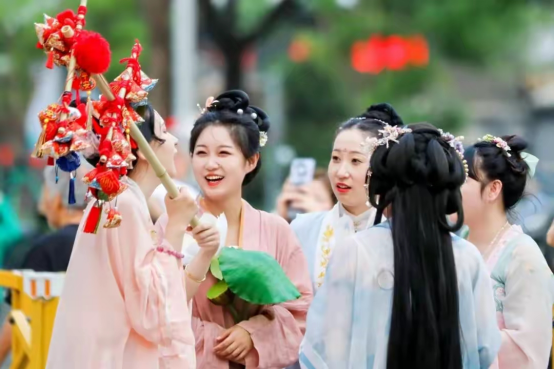Tang Suit generally refers to a traditional costume developed after the Tang Dynasty. Though named with “Tang”, its forms and styles have integrated multiple cultural influences through later evolution. It embodies the rich clothing culture and historical heritage of the Chinese nation. Over time, Tang Suit has gradually become a representative modern Chinese costume. Especially in major festivals, weddings and other formal occasions, it is often used as a solemn attire. Its design not only fits traditional occasions but also allows people to feel the charm of traditional culture in modern life.
You may be interesting this: How to Choose a Well-Fitted Tang suit

Requirements for Wearing Tang suit in Daily Life
Nowadays, more and more people favor traditional costumes, hoping to explore their unique temperament from them. Tang suit is a typical example. Wearing Tang suit in daily life is for looking good and feeling comfortable. However, in formal occasions, Tang suit should not only be comfortable and good-looking but also consider the sense of boundaries and implicit requirements of formal occasions. Thus, the dressing rules for Tang suit in formal occasions are more complicated than those in daily life.

What Are the Classic Styles of Tang suit?
For formal occasions, men can first choose stand-collar buttoned tops or improved Zhongshan suits. Women can opt for stand-collar cheongsams or new Chinese-style dresses. These are classic formal styles of Tang suit, suitable for solemn and elegant major occasions.

What Are the Classic Styles of Tang suit?
Meanwhile, for formal occasions, the fabric combination is also key to highlighting temperament. Smooth and crisp silk, brocade satin or fine wool are preferred. Avoid easily wrinkled fabrics like cotton and linen. In terms of color, stable and deep colors such as navy blue, black, wine red and dark green are the main choices. Avoid high-saturation colors or large-area prints. After all, it is for banquets or important events, not for stage performances, to avoid becoming a “festive background board”.
Tang suit for formal occasions also has strict requirements on tailoring. It must fit well: shoulder lines should be neat, waistlines should be sharp. For women’s cheongsams, special attention should be paid to the smooth curves of the chest, waist and hips. Sleeve length should reach the wrist. People with a slightly plump figure can choose dark-colored Tang suit or those with simple designs. Those with a slightly thin figure can add a sense of strength to their temperament through textured fabrics.

How to Match Tang suit on Formal Occasions?
For Tang suit in formal occasions, detailed matching plays a finishing role. Men can match traditional multi-layered cloth shoes, matte leather Monk shoes or loafers. The color of the shoes should also echo the clothes. Women can choose high heels or embroidered shoes.
In terms of accessories, the principle is “quality over quantity”. A warm jade cufflink, a simple watch, an exquisite handbag, a silk pocket square, women’s jadeite earrings and elegant brooches are all personal delicate ideas in accessories, adding the finishing touch to the overall look.
Choosing Tang suit for important occasions is not only a tribute to tradition but also a bold declaration of personal temperament. Mastering dressing skills allows you to show calm confidence and ease in handling things.







